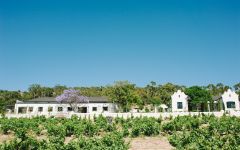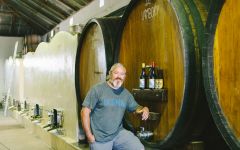Badenhorst Secateurs Chenin Blanc 2012
-
Robert
Parker -
Wine
Spectator




Product Details
Your Rating
Somm Note
Winemaker Notes
Professional Ratings
-
Robert Parker's Wine Advocate
The 2012 Secateurs Chenin Blanc has a light but pure bouquet with lemon peel, grapefruit and hints of wet wool. The palate is crisp and vibrant on the entry with touches of lanolin and litchi nuts. This is so well balanced – uncomplicated but delicious.
-
Wine Spectator
Bright and engaging, showing lots of white peach, Jonagold apple and Cavaillon melon notes, offset by a floral edge. The pure, unadorned finish sails on.
Other Vintages
2022-
James
Suckling
- Decanter
-
Wilfred
Wong
-
Wine &
Spirits
-
Wine
Spectator
-
Wilfred
Wong -
Wine &
Spirits
-
Robert
Parker
-
Robert
Parker






The property is owned by the dynamic and good-looking cousins Hein and Adi Badenhorst. They are originally from Constantia. Their grandfather was the farm manager of Groot Constantia for 46 years. Their fathers were born there and farmed together in Constantia, during the days when people still ate fresh vegetables and Hanepoot grapes, drank Cinsault and there were a lot less traffic lights and hippies still had a presence. Together these two have restored a neglected cellar on the farm that was last used in the 1930s to make natural wines in the traditional manner.

Unquestionably one of the most diverse grape varieties, Chenin Blanc can do it all. It shines in every style from bone dry to unctuously sweet, oaked or unoaked, still or sparkling and even as the base for fortified wines and spirits. Perhaps Chenin Blanc’s greatest asset is its ever-present acidity, maintained even under warm growing conditions. Somm Secret—Landing in South Africa in the mid 1800s, today the country has double the acreage of Chenin Blanc planted compared to France. There is also a new wave of dedicated producers committed to restoring old Chenin vines.

With an important wine renaissance in full swing, impressive red and white bargains abound in South Africa. The country has a particularly long and rich history with winemaking, especially considering its status as part of the “New World.” In the mid-17th century, the lusciously sweet dessert wines of Constantia were highly prized by the European aristocracy. Since then, the South African wine industry has experienced some setbacks due to the phylloxera infestation of the late 1800s and political difficulties throughout the following century.
Today, however, South Africa is increasingly responsible for high-demand, high-quality wines—a blessing to put the country back on the international wine map. Wine production is mainly situated around Cape Town, where the climate is generally warm to hot. But the Benguela Current from Antarctica provides brisk ocean breezes necessary for steady ripening of grapes. Similarly, cooler, high-elevation vineyard sites throughout South Africa offer similar, favorable growing conditions.
South Africa’s wine zones are divided into region, then smaller districts and finally wards, but the country’s wine styles are differentiated more by grape variety than by region. Pinotage, a cross between Pinot Noir and Cinsault, is the country’s “signature” grape, responsible for red-fruit-driven, spicy, earthy reds. When Pinotage is blended with other red varieties, like Cabernet Sauvignon, Merlot, Syrah or Pinot Noir (all commonly vinified alone as well), it is often labeled as a “Cape Blend.” Chenin Blanc (locally known as “Steen”) dominates white wine production, with Chardonnay and Sauvignon Blanc following close behind.
